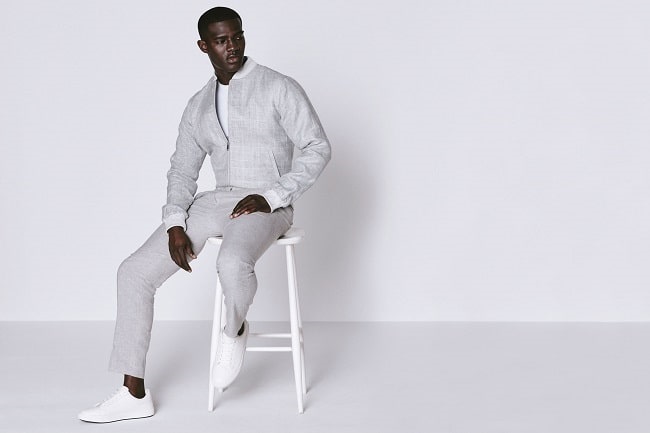1
HOME > Trends >
GOLDMAN SACHS GOES BUSINESS CASUAL
WHAT THIS MEANS FOR BUSINESS SUITS
Written by Ivan Yaskey in Trends on the 21st March 2019

Admit it – no one wants to be or seem old. It’s why we stay reasonably up to date on the latest technologies, and why an increasing number of men opt for cosmetic procedures to hide their brow lines. Beyond appearances, being a stodgy rule-follower with no room for leeway gets you pegged as an aged fuddy-duddy who’s yet to get caught up with the times. In terms of the job market, dress codes colour these impressions. We see the tech industry – directly in Silicon Valley and beyond – as a young man’s place, where hoodies, jeans, and trainers are the norm. Conversely, law and finance – both known for an older workforce – cling to their three-piece suits and paper documents.
However, these "traditional" industries are changing, especially as Millennials become the dominant generation out there and Gen Z gets ready to enter the working world. As one sign of the shifting tides, Goldman Sachs announced plans to loosen up the company dress code earlier in March to keep up with the evolving workplace. A memo to all employees stated: "Goldman Sachs has a broad and diverse client base around the world, and we want all of our clients to feel comfortable with and confident in our team, so please dress in a manner that is consistent with your clients' expectations."

Yet, what seems like a refreshing change of pace is fairly inevitable. Two years ago, J.P. Morgan switched to a business casual dress code, and starting in 2017, Goldman Sachs gave its tech and digital employees the option to dress in a more relaxed manner. And, breaking down the suits-versus-jeans divide that emerged in American workplaces in the 2000s, the company’s latest effort lets all workers dress flexibly – or, more precisely, as the situation dictates. In response, Indochino announced it would help Goldman Sachs’ employees understand and get better-equipped for less formal dressing. While Goldman Sachs claims it, in fact, instituted a business casual dress code as far back as the early 2000s, its announcement simply reflects new attitudes toward professionalism and appearance. Specifically, that employee performance and customer satisfaction don’t always correlate with hard guidelines for a suit and collared shirt. Rather, based upon figures from the Society for Human Resource Management, 88 percent of all employers in 2018 let their staff dress casually – up from 81 percent five years ago – with roughly half allowing it for everyday attire. So, with chinos, blazers, and sweaters replacing the traditional work uniform, we started thinking: What does this mean for the suit? At least in the US and UK, is it becoming obsolete?

It’s an Employees’ Market
And everyone has to get caught up. No – seriously – in spite of Brexit and President Trump’s tariff-fueled national dumpster fire, the economy has gradually crept up from the dregs of the Great Recession. Yet, a visible number of employers continue to operate like it’s 10 years ago, having potential workers jump through hoops, depressing wages, cutting positions with little-to-no notice, and keeping strict, non-negotiable guidelines in place. The workforce has taken note, and it’s not uncommon to see your coworkers jump ship for a better offer – pay, perks, and, frankly, dress code. If that £10,000-higher salary comes with the option to work in dark denim and a rollneck? Even better. As such, at least in the US, employers of all sizes have started catching on – albeit at a glacial pace. Getting rid of strict suit-and-tie dress codes for men is one such shift. Especially, too, Silicon Valley’s salaries are pretty much on par with the finance industries, and a worker having to make a decision might just opt for the former. With Millennials making up three-quarters of Goldman Sachs’ workforce, it’s downright anachronistic – if not a shoot-yourself-in-the-foot move – to stick with a dated dress code. Although, over the past couple of years, the casual suit has become a thing, a suit itself is rarely required on the job. Wear your button-down and chinos or stick to your pinstripes – provided they still seem polished and professional. Either way, your performance, more than your appearance and ability to follow outdated rules, should keep you from the chopping block.

A Suit’s Not Always Necessary
Think about it. When’s the last time you truly needed a suit for the job? That client meeting a few months ago? That presentation you put together to discuss your yearly raise? Between these points – months, really – you could’ve done without it. And, if you’re in a non-client-facing role, you could truly skate by in a polo and jeans, perhaps with an unstructured sport coat and Chelsea boots when you’ve got to seem presentable. Beyond the lack of practicality, it presents for even office jobs, the suit – and the tie, too – is losing its place as the ultimate symbol of respect. As both ‘80s’ Wall Street culture and greed leading to the late ‘00s mortgage crash showed us, charm and a sharp suit simply mask a bunch of lies and false promises. Good looks don’t always translate to good needs. In the aftermath, it’s a worker’s actions – from showing up on time and completing projects to sticking to his word – that hold more weight, especially with building customer trust. And, to talk about displays of wealth, a Brioni suit, paired with Ferragamo shoes, isn’t just the only way to show off your high salary. That Supreme hoodie and Yeezy Boosts? Especially if someone stood in line for a drop, they’re just as much of a status symbol among the younger set.

Vagaries Keep It Around
Here’s the kicker: Business casual isn’t a free-for-all. You can’t walk into the office in above-the-knee shorts and a metallic camp collar shirt. And, leave your neons at home, lest someone file a complaint about you being a literal eyesore. On the other hand, Goldman Sachs, based on the memo circulated, kept it vague, essentially leaving it up to the employee: "Casual dress is not appropriate every day and for every interaction and we trust you will consistently exercise good judgement in this regard. All of us know what is and is not appropriate for the workplace." But, what looks like leisure and freedom opens up a whole new Pandora’s Box. Women, if you didn’t realise, have dealt with this ambiguity for years: What’s actually acceptable, based on setting, occasion, body type, and whims of management, and not just lip service? A seemingly low-cut V-neck blouse ends up passable on some, yet turns into a violation on others. So, logically, you opt for a higher neck. Yet, a manager or even a coworker may complain the “fitted cut” is simply “too revealing.” The reality is, there’s a narrow path between what’s “presentable” and what could get you written up. The less-typical your body type is – muscular, overweight, or super-skinny – the narrower it becomes. For too long, donning a suit meant you were good to go. No complaints, and no questioning. It was easy, and required little to no thought, let alone style sense. You could get away with your father’s poorly fitting garb, or show up in Dior Homme. Short of having holes on the back of your trousers, it typically made minimal difference.

Now, though, Goldman Sachs’ shift means you’ve got to actually care. Maybe start to educate yourself on style rules, and avoid those lazy bro pieces. And, from here, you’ve got to worry about how others will perceive you. Will the cut of your trousers get you marked a “distraction” and a “slob” who’s too incompetent to follow the implied rules? Or, will a fit that hits right at the top of your lace-ups mirror your attention to detail? It might make you uneasy, but your boss is still taking a glance. For those of us with a decent grasp of style, we’ll do all right – and still take that suit out for a spin on occasion. The rest? Get ready to have your attire questioned from the moment you grab your morning coffee.
Do you wear a suit for work? #dresscode
— Menswear Style (@MenswearStyle) March 19, 2019

Trending
2
3
4
5
6
7
8
9
10










